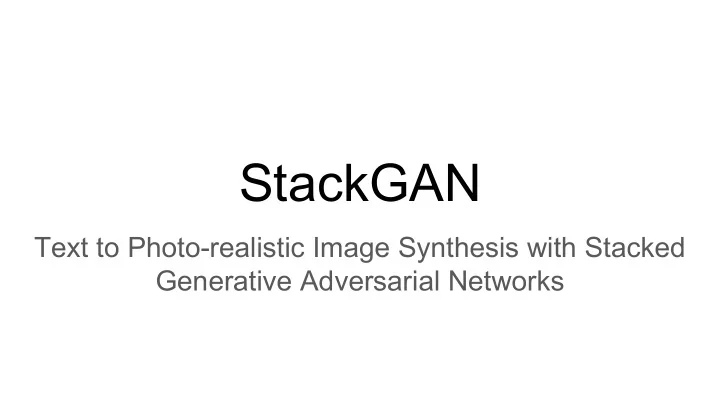

StackGAN Text to Photo-realistic Image Synthesis with Stacked Generative Adversarial Networks
The Problem:
2-Stage Network ● Stage 1. ○ Generates 64x64 images ○ Structural information ○ Low detail ● Stage 2. ○ Requires Stage 1. output ○ Upsamples to 256x256 ○ Higher detail, photorealistic Both stages take in the same conditioned textual input
Generalized Adversarial Networks (GAN) Composed of two models that are alternatively trained to compete with each other. ● The Generator G optimized to generate images that are difficult for the ○ discriminator D to differentiate from real images. ● The Discriminator D ○ optimized to distinguish real images from the synthetic images generated by G .
Loss Functions Scores from The Discriminator: Then alternate: Maximizing and minimizing
Stage-I Generator ● c - vector representing input sentence ● z - noise sampled from a unit gaussian distribution
Actually Creating Images Nice Deconvolution Animation But really they’re upsampling the activation maps using nearest neighbors-- then applying deconvolution
Stage-I Discriminator Down-Sampling ● Images ○ Stride-2 convolutions, Batch Norm., Leaky ReLU ○ 64 x 64 x 3 → 4 x 4 x 1024 ● Text ○ Fully-connected layer: � t → 128 ○ Spatially replicate to 4 x 4 x 128 ● Depth Concatenate ○ Total of 4 x 4 x 1152 Score ● 1x1 convolution, followed by 4x4 convolution ○ Produces scalar value between 0 and 1
Stage-II Generator ● Takes in… ○ Stage-I’s image ○ ‘Conditioned augmentation’ representing input text ● Downsampling via CNN, Batch Norm, Leaky Relu ● Residual Blocks, similar to ResNet ○ To jointly encode image and text features
Conditioning Augmentation Text Encoding ● Uses a “hybrid character-level convolutional recurrent neural network” ● Same as Reed et al. “GAN Text to Image Synthesis” paper Augmentation ● Randomly sample “latent variables” from the independent Gaussian distribution Ɲ ( � ( � t ), � ( � t ))
Variations due purely to Conditioning Augmentation The noise vector z and the text encoding vector � are fixed for each row. Only the samples from the distribution Ɲ ( � ( � t ), � ( � t )) actually change between images.
Stage-II Discriminator Down-sampling ● Same as Stage-I, but more layers Loss functions ● Same as before, but now G is “encourage[d] to extract previously ignored information” in order to trick a more perceptive and detail-oriented D .
Evaluation ● State of the art Inception score, 28.47% and 20.30% improvement ● People seem to like the results, too
Recommend
More recommend